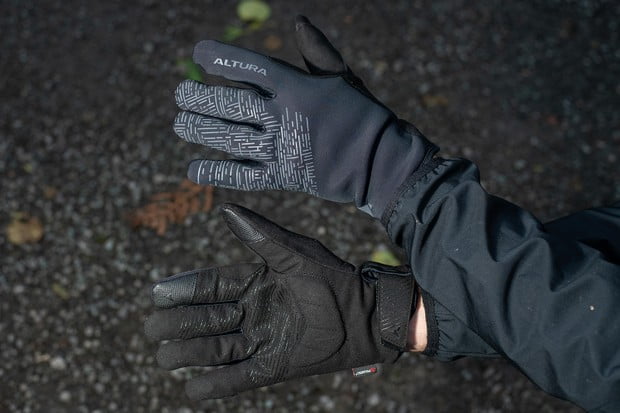
It has a long, snug-fitting, Velcro-adjustable cuff and a silicone palm print on the Amara material – a synthetic suede with a leathery feel – that provides the sort of grip you want in a winter glove. There is a padded section covering the heel of the hand, too.
The thumb and index fingers have a smartphone-compatible capacitive area and there is a softer microfibre wipe zone on the thumbs. The pair of medium gloves I tested weighed 106g.
Altura Polartec Waterproof Glove performance
The gloves have a snug fit, created by the relatively short space for fingers, which caused mine to bottom out onto the ends. The palm is fairly voluminous in its size and fit, but overall bulk thanks to a moderate use of insulation and softer, flexible materials, is low.
Despite the fingers feeling quite short, my hands’ movement wasn’t restricted in any way, even when in a clenched fist.
General feel on the bars is good, thanks to the type of insulation used. I could sense what the bike was doing through my hands, where there was no over-damping of the ride.
Despite not having the dexterity of summer gloves, I could still feel the brake and gear levers without issue.

The padded section on the heel felt a bit bulky, but this didn’t create any discomfort.
The insulation felt a bit clumpy at times and required some finger movement to reposition it. It was possible to feel the outer layer of the glove rotate as my hands twisted on the bars, clamping the inner fleece with my fingers.
But even with sweaty and clammy hands, it wasn’t difficult to put on or remove the gloves, with the liner staying put.
The long, adjustable cuff was slim enough to slide under jackets, rather than fitting over the top of them. This created a good weather seal, keeping water out and heat in.

The warmth the Altura gloves provided was commendable for the thickness of the insulation, and my hands maintained their heat even as temperatures dropped. There wasn’t enough insulation to generate heat, however. Because there is a balance between feel, insulation and heat, they aren’t suited to the coldest, or least active days on the hill.
Although the palms and backs aren’t coated with a DWR treatment, so water doesn’t bead, they are totally waterproof, resisting water penetration on long, wet rides and during the two-minute submersion test. Altura’s waterproof membrane worked flawlessly.
They are also windproof, and I couldn’t feel any cold air trickling over my knuckles, drawing heat from my fingers.
The touchscreen-compatible thumb and finger only worked intermittently, however, and the bulk of the gloves meant that anything other than scrolling on the phone wasn’t possible while wearing them.
How we tested
We tested five pairs of winter gloves back-to-back in the widest variety of conditions we could find. Temperatures ranged from a mild 10 degrees celsius, right the way down to a positively chilly -5 degrees celsius. We endured cold, crisp and sunny days, as well as the heaviest rain the great Scottish mountains could provide. We tested the gloves from low-intensity ebike rides, through to heart-pummelling cross-country epics to really get a handle on performance.
[“source=bikeradar”]




